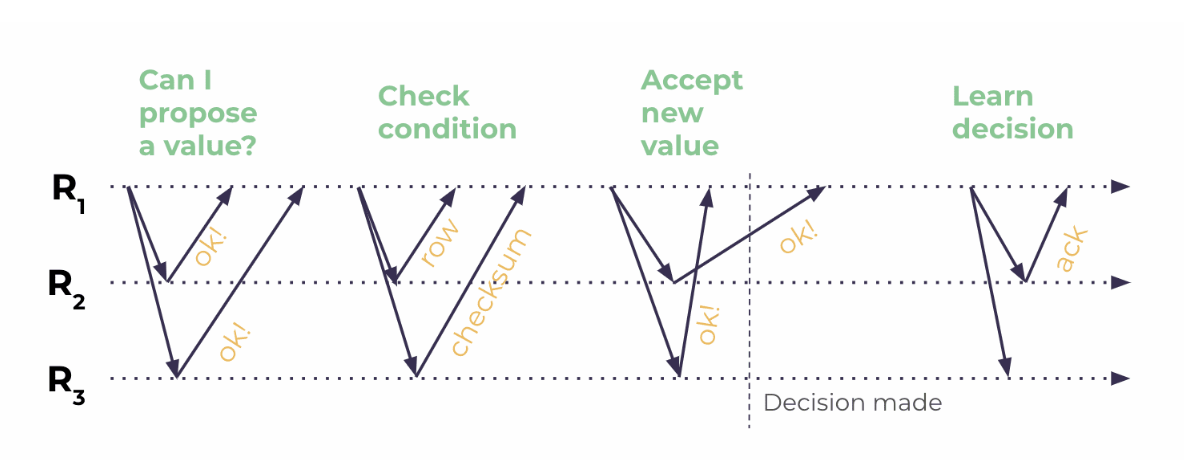Cassandra Lightweight Transactions (LWT) FAQs
Key Features of Lightweight Transactions in Cassandra
Atomicity & Isolation. Ensures that conditional updates are fully completed or not applied at all, preventing partial writes.
Serial Consistency. Guarantees that all conditional updates on one partition appear in a single, serial order across replicas. This safely supports uniqueness constraints.
Compare-and-Set (CAS) Mechanism. Uses conditions like IF NOT EXISTS or IF column = value to check existing data before applying changes.
Paxos Consensus Protocol. Implements a multi-phase, distributed consensus algorithm to coordinate writes across nodes, ensuring agreement before committing changes.
Higher Latency Compared to Normal Writes. Due to multiple Paxos rounds (Prepare, Propose, Accept, and Commit), LWTs take longer than standard Cassandra writes.
Partition-Level Scope. All conditional clauses in an LWT must target the same partition key; multi-partition conditional batches are not supported.
Consistency Trade-offs. Provides serial consistency (stronger than eventual consistency) but may impact throughput in high-write environments.
LWTs are useful for scenarios requiring unique constraints, optimistic concurrency control, or preventing race conditions, but should be used selectively due to performance overhead.
Cassandra Lightweight Transactions Performance
1. Higher Latency Due to Paxos Overhead
- Cassandra’s LWTs require multiple Paxos rounds (Prepare, Propose, Accept, Commit), increasing the number of network and disk operations compared to standard writes.
- This results in higher write latency, often 3-4× slower than regular Cassandra writes.
2. Increased Coordination Costs
- Since LWTs require consensus among all replicas for a partition, they introduce extra coordination overhead, impacting performance in large clusters.
3. Reduced Throughput
- Due to the sequential nature of the Paxos protocol, throughput is significantly lower than regular writes, making LWTs less suitable for high-ingestion workloads.
4. Limited Scalability for High-Write Applications
- Heavy use of LWTs can create contention on frequently updated partitions, leading to increased conflicts and retries.
- They are best suited for low to moderate write workloads where strong consistency is required.
5. Partition-Level Serialization
- LWTs operate at the partition level, meaning concurrent updates to the same partition can cause contention, further reducing performance.
Best Practices for Optimizing Cassandra LWT Performance
- Use LWTs Only When Necessary. Apply them only for cases requiring strong consistency, such as enforcing uniqueness or handling race conditions.
- Optimize Partitioning Strategy. Distribute data across partitions to minimize contention.
- Use Batching Carefully. A multi-statement single-partition batch still runs one Paxos instance—but only if every statement targets the same partition. Don’t batch for latency—batch to keep logically-related conditionals together atomically.
- Monitor Latency and Contention. Track Paxos contention metrics to identify bottlenecks and adjust data models accordingly.
- Consistent Reads After LWT. When reading data written by an LWT, use SERIAL or LOCAL_SERIAL consistency to ensure you observe its latest committed state.
How ScyllaDB Sets Itself Apart from Cassandra LWTs?
ScyllaDB, a popular Apache Cassandra alternative, has developed an LWT implementation that is fundamentally more efficient than Cassandra’s LWTs. Most notably, ScyllaDB’s LWT implementation requires only three round trips instead of four. While Cassandra issues a separate read query to fetch the old record, ScyllaDB piggybacks the read result on the response to the prepare round. This performance difference is significant enough that users who previously avoided LWTs in Cassandra due to performance issues might find them viable in ScyllaDB (which is API-compatible with Cassandra).
